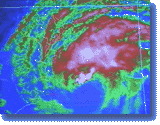H U R R I C A N E S E A S O N
 In
the Eastern Pacific, hurricanes begin forming by mid-May, while in the Atlantic,
Caribbean and Gulf of Mexico, hurricane development starts in June. For the
United States, the peak hurricane threat exists from mid-August to late October
although the official hurricane season extends through November. Over other
parts of the world, such as the western Pacific, hurricanes can occur year-round.
(From NOAA's Climate Prediction Center.)
In
the Eastern Pacific, hurricanes begin forming by mid-May, while in the Atlantic,
Caribbean and Gulf of Mexico, hurricane development starts in June. For the
United States, the peak hurricane threat exists from mid-August to late October
although the official hurricane season extends through November. Over other
parts of the world, such as the western Pacific, hurricanes can occur year-round.
(From NOAA's Climate Prediction Center.)
Hurricane researcher Chris Landsea (NOAA/OAR/AOML) has been collecting a great variety of quotes about the massive storms he studies, and one of them is an old Florida fishermen's saying which summarizes the science in rhyme: